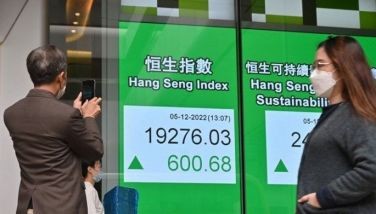S&P: Phl, AsPac banks face risks to financial stability
MANILA, Philippines - Asia-Pacific banks, including those from the Philippines, are facing risks of “shakier†asset quality, lower profit margins and a rise in property prices which could impact on over-all financial stability, a debt watcher said.
“Although the region’s economy is likely to show a moderate recovery in 2013 after a sharp drop in growth in 2012, Standard & Poor’s Ratings Services (S&P) expects factors constraining the asset quality of Asia-Pacific banks to persist,†a report said on Tuesday.
“Hikes in property prices, some fueled by easy monetary conditions in the global market, pose additional risk to banking systems in many countries,†it added.
The report titled “Asia-Pacific Banking Outlook 2013: Shakier Asset Quality Remains A Key Risk†followed an earlier evaluation of the Philippine banking system that maintained S&P’s “stable†forecast despite underscoring credit risk.
That outlook is shared by 78 percent of banks under S&P’s radar, the report on Tuesday said, indicating higher capital and strong liquidity provide cushion on possible threats.
The credit rater said the low interest environment has provoked some banks to take in more risks, most of the time by extending more loans, to protect their profits.
Non-performing loans have been rising in China, Japan, India and Singapore and may continue to do so as economic growth in the region remained slow, thereby reducing chances for lenders to boost their profits.
S&P, nonetheless, has forecast a five-percent expansion for Asia-Pacific countries, “improving slightly†from last year’s 4.7 percent. Though stronger, the debt watcher said the region will be put under pressure by the crises in developed nations.
This, in effect, would prompt central banks to keep policy loose to provide support against the fragile global economy. In turn however, easy monetary conditions have their own downside.
“The region's strong economic prospects, coupled with easing of monetary conditions, have fueled property purchases,†S&P said, noting “sharp†increases in property prices that could trigger asset bubble formations.
It was quick to note however that regulators have responded by tightening controls on property loans, although there were some “limitations†as far as foreign investors investing in the country is concerned.
On the flipside, loans have also increased as economic activity picks up. Notably, Indonesia, Thailand and the Philippines have experienced double-digit credit expansion for the past few months, S&P said.
This could provide support to banks’ profit margins, already being “squeezed†by the low interest environment and “intense competition†at home and abroad, it explained.
“In our view, strong discipline in loan pricing is a key factor if banks want to maintain stable profits,†the report said.
Lastly, “proactive†measures from governments, which would want to protect their own credit ratings, will also be helpful to thwart any possible credit problems that may arise.
“We view the vast majority of governments in the region as ‘highly supportive’ and believe they will take proactive measures to support creditors in their respective banking sectors,†S&P said.
- Latest
- Trending




























